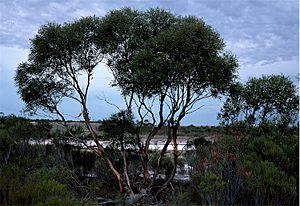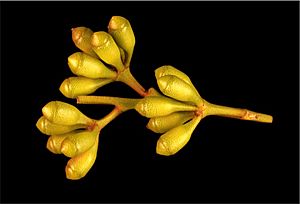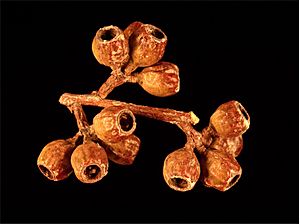Salt lake mallee facts for kids
Quick facts for kids Salt lake mallee |
|
|---|---|
 |
|
| Eucalyptus halophila near Esperance | |
| Scientific classification | |
| Genus: |
Eucalyptus
|
| Species: |
halophila
|
The Eucalyptus halophila, also called salt lake mallee, is a special type of mallee or shrub. It grows only in Western Australia. This plant has smooth bark that is white and grey. Sometimes, the bark at the bottom of its trunk is rough. It has long, narrow leaves, and its flower buds usually grow in groups of seven. The flowers are white, and its fruit looks like a small, round barrel.
Contents
What Does Salt Lake Mallee Look Like?
The salt lake mallee is a shrub or a mallee tree. It usually grows about 1 to 4 meters (3 to 13 feet) tall. Sometimes it can reach 7 meters (23 feet). It can also be a shrub up to 2 meters (7 feet) tall. This plant has a special woody swelling at its base called a lignotuber. This helps it regrow after a fire.
Its bark is smooth and light grey or white. The lower part of its stems might have rough, stringy bark. Young plants have long, thin leaves, about 40 to 85 millimeters (1.6 to 3.3 inches) long. Adult leaves are also long and narrow, 50 to 80 millimeters (2.0 to 3.1 inches) long. They are a dull green color on both sides.
The flower buds grow in groups of seven, or sometimes three. They are found where the leaves meet the stem (called the leaf axil). Each group of buds sits on a stalk called a peduncle, which is 5 to 13 millimeters (0.2 to 0.5 inches) long. The individual buds have tiny stalks called pedicels. Mature buds look like pears. They are 4 to 5 millimeters (0.16 to 0.20 inches) long.
The salt lake mallee blooms from January to May. Its flowers are a creamy white color. After flowering, it produces a woody fruit. This fruit is shaped like a short sphere or a barrel. It is 5 to 9 millimeters (0.20 to 0.35 inches) long.
How Did It Get Its Name?
The Eucalyptus halophila was officially described in 1980. This was done by two scientists, Denis Carr and Maisie Carr. Maisie Carr found a sample of the plant near a small salt pan in Dalyup.
The plant's scientific name, halophila, has a special meaning. It comes from ancient Greek words. "Halo" means "salt," and "-philus" means "loving." So, halophila means "salt-loving." This name perfectly describes where this plant likes to grow!
Where Does It Live?
The salt lake mallee grows in sandy clay soils. It is found in flat areas next to salt lakes. It lives in shrubland, which is a type of land with many shrubs.
This plant is only found in the area around the Dalyup River. This is between Dalyup and Mount Ney, near Esperance in Western Australia. It grows in specific natural areas known as the Esperance Plains and Mallee regions.
Is It Endangered?
The Western Australian Government's Department of Parks and Wildlife has looked at the Eucalyptus halophila. They have classified it as "not threatened." This means it is not currently in danger of disappearing.
Growing Salt Lake Mallee
You can buy the salt lake mallee as seeds or as small plants in tubes (called tubestock). People grow it because it's a nice ornamental plant, meaning it looks good. It can also be used as a low shelter plant to protect other things.
This plant is tough! It can handle frost, salt, and dry conditions (drought). It also grows quite fast.



